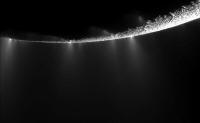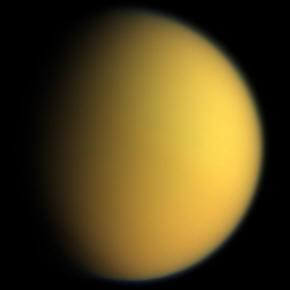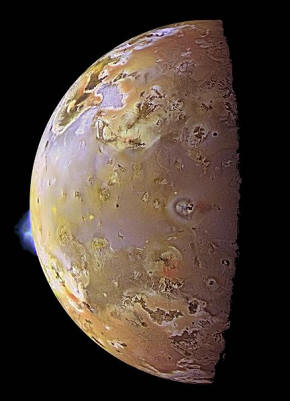Creation Science Rebuttals
Institute for Creation Research
Youthful Solar System or Just Empty Claims?
ICR News, 13 February 2013
By Greg Neyman
© Old Earth Ministries
First Published 18 Feb 2013
A common young earth argument goes like this...scientists who believe the universe is old cannot explain "such and such," therefore the universe must be young. Such an argument can be seen in an Institute for Creation Research article entitled "Youthful Solar System Bodies Puzzle Evolutionary Scientists."1
The article discusses four features of our solar system: Saturn's rings, watery geysers on Saturn's moon Enceladus, methane in Titan's atmosphere, and volcanic activity on Jupiter's moon Io. First let me state for the record, that just because scientists don't fully understand how these features exist, their lack of understanding of them DOES NOT mean that the earth is young. If the author, Jake Hebert, has solid scientific proof that these features are young, he should present it. He does not present any evidence in this article...he merely claims that these items are not understood by scientists.
The argument goes that after billions of years, the rings should have been darkened by dust from comets and asteroids. This section found on Wikipedia explains:
The brightness and purity of the water ice in Saturn's rings has been cited as evidence that the rings are much younger than Saturn, perhaps just 100 million years old, as the infall of meteoric dust would have led to darkening of the rings. However, new research indicates that the B Ring may be massive enough to have diluted infalling material and thus avoided substantial darkening over the age of the Solar System. Ring material may be recycled as clumps form within the rings and are then disrupted by impacts. This would explain the apparent youth of some of the material within the rings.2
Research from the late 1990's indicate that the rings may be less than 100 million years old. Although they may be young, they are not young enough for YEC standards.3
Geysers on Enceladus
This claim is that the geysers (pictured) are
giving off heat, which should cool the moon quickly, leading to a cessation of geyser activity. An
explanation has been put forth by scientists that gives a model for
tidal heat production and addresses other issues.4
I wish I could state more, but all I have to go on is the abstract.
The young earth author does nothing to dispute this study (dated
2006, well before this YEC article was published in 2013).
moon quickly, leading to a cessation of geyser activity. An
explanation has been put forth by scientists that gives a model for
tidal heat production and addresses other issues.4
I wish I could state more, but all I have to go on is the abstract.
The young earth author does nothing to dispute this study (dated
2006, well before this YEC article was published in 2013).
All we are left with is a claim that the moon should be cool and geologically dead if it were very old...no actual evidence to back up the claim is presented.
Titan's Methane
This argument states that
Titan's atmospheric methane "should have been depleted after only a few tens of millions of years." Here is a
paragraph from Wikipedia:
depleted after only a few tens of millions of years." Here is a
paragraph from Wikipedia:
Energy from the Sun should have converted all traces of methane in Titan's atmosphere into more complex hydrocarbons within 50 million years — a short time compared to the age of the Solar System. This suggests that methane must be somehow replenished by a reservoir on or within Titan itself. That Titan's atmosphere contains over a thousand times more methane than carbon monoxide would appear to rule out significant contributions from cometary impacts, since comets are composed of more carbon monoxide than methane. That Titan might have accreted an atmosphere from the early Saturnian nebula at the time of formation also seems unlikely; in such a case, it ought to have atmospheric abundances similar to the solar nebula, including hydrogen and neon. Many astronomers have suggested that the ultimate origin for the methane in Titan's atmosphere is from within Titan itself, released via eruptions from cryovolcanoes. A possible biological origin for the methane has not been discounted.5
As you can see, there are some proposed solutions for methane being constantly added to Titan's atmosphere. Hebert does not address these proposals, so we are left with the "should have been depleted" argument, without any supporting evidence to discount any of the proposed methane sources.
Io's Volcanism
About this, Hebert only mentions a single sentence:
Likewise, the extreme volcanic activity on Jupiter's moon Io seems incapable of being sustained for extremely long periods of time.
Hebert's statement doesn't really say much. Scientists are certain that Io's intense volcanism (picture shows a plume from one of over 400 active volcanoes) is due to tidal heating. The following excerpt is from Wikipedia:
Io's main source of internal heat comes from the
dissipation of
tidal forces generated by Jupiter's gravitational pull. This
external heating differs from the
internal heat source for volcanism on Earth, which is a result
of radioactive
isotope decay and residual heat from
accretion. In the Earth, these internal heat sources drive
mantle convection, which in turn causes volcanism through
plate tectonics.
internal heat comes from the
dissipation of
tidal forces generated by Jupiter's gravitational pull. This
external heating differs from the
internal heat source for volcanism on Earth, which is a result
of radioactive
isotope decay and residual heat from
accretion. In the Earth, these internal heat sources drive
mantle convection, which in turn causes volcanism through
plate tectonics.
The tidal heating of Io is dependent on the moon's distance from Jupiter, its orbital eccentricity, the composition of its interior, and its physical state. Its Laplace orbital resonance with Europa and Ganymede maintains Io's eccentricity and prevents tidal dissipation within Io from circularizing its orbit. The eccentricity leads to vertical differences in Io's tidal bulge of as much as 100 meters (330 ft) as Jupiter's gravitational pull varies between the periapsis and apoapsis points in Io's orbit. This varying tidal pull also produces friction in Io's interior, enough to cause significant tidal heating and melting. Unlike Earth, where most of its internal heat is released by conduction through the crust, on Io internal heat is released via volcanic activity and generates the satellite's high heat flow (global total: 0.6–1.6 × 1014 W). Models of its orbit suggest that the amount of tidal heating within Io changes with time, and that the current heat flow is not representative of the long-term average. The observed release of heat from Io's interior is greater than estimates for the amount presently generated from tidal heating, suggesting that Io is cooling after a period of greater flexing.6
In contrast to this scientific explanation, Hebert simply claims "Likewise, the extreme volcanic activity on Jupiter's moon Io seems incapable of being sustained for extremely long periods of time." In reality, Hebert "seems incapable" of making a valid scientific argument for a young earth...all he does is spout accusations without providing any factual evidence.
1 Jake Hebert, Youthful Solar System Bodies Puzzle Evolutionary Scientists, ICR website.
2 "Saturn's Rings May Be Old Timers". NASA/JPL and University of Colorado. 2007-12-12. Retrieved 2008-01-24.
3 Cuzzi, J. N. and P. R. Estrada, 1998. Compositional evolution of Saturn's rings due to meteoroid bombardment. Icarus 132(1): 1-35.
4 http://adsabs.harvard.edu/abs/2006AdSpR..38..788C
5 http://en.wikipedia.org/wiki/Atmosphere_of_Titan
6 https://en.wikipedia.org/wiki/Io_(moon))
If you are not a Christian, and you have been holding out on making a decision for Christ because the Church always preached a message that was contrary to what you saw in the scientific world, then rest assured that the Bible is the inerrant Word of God, and you can believe in Christ and receive salvation, while still believing in an old earth. Click here for more.
Are you a Christian who believes in young earth creationism? Now that we have shown the many difficulties of the young earth creation science model in this and many other articles, how does this impact your Christian life? If you are a young-earth creationism believer, click here.
More Institute for Creation Research Rebuttals
Leave a comment about this article on our Facebook page.
Did you know that you can be a Christian,
and believe that the earth is billions of years old? You can even
believe in evolution and be a Christian. There is no conflict
between science and the Bible...all one needs is a proper
understanding how to merge science and the Bible. To learn more
about old earth creationism, see
Old Earth Belief,
or check out the article
Can You Be A
Christian and Believe in an Old Earth?
Feel free to check out more of this website. Our goal is to
provide rebuttals to the bad science behind young earth creationism,
and honor God by properly presenting His creation.
